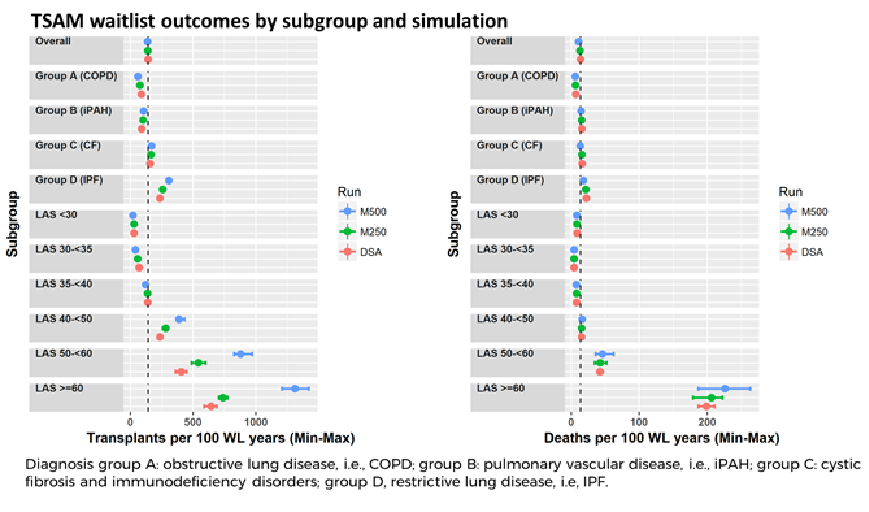Simulation of DSA-Free Lung Allocation
1SRTR, Minneapolis, MN, 2OPTN, Richmond, VA, 3Univ. of Michigan, Ann Arbor, MI, 4Univ. of WA, Seattle, WA, 5Mayo Clinic, Rochester, MN, 6Cleveland Clinic Foundation, Cleveland, OH
Meeting: 2019 American Transplant Congress
Abstract number: C337
Keywords: Allocation, Lung
Session Information
Session Name: Poster Session C: Lung: All Topics
Session Type: Poster Session
Date: Monday, June 3, 2019
Session Time: 6:00pm-7:00pm
 Presentation Time: 6:00pm-7:00pm
Presentation Time: 6:00pm-7:00pm
Location: Hall C & D
*Purpose: In November 2017, the OPTN Executive Committee removed donation service area (DSA) as the first unit of adult donor lung allocation, replacing it with a 250 nautical mile (NM) radius circle around the donor hospital. The Scientific Registry of Transplant Recipients used thoracic simulated allocation modeling (TSAM) to test outcomes of 250NM and 500NM compared with DSA as the first unit of allocation.
*Methods: TSAM included all candidates, recipients, and donors, July 1, 2009-June 30, 2011, and simulated match-runs according to former policy, current policy (250NM), and 500NM as the first unit of allocation.
*Results: Overall lung transplant counts and rates were similar in the 250NM and DSA-first simulations. Waitlist mortality rates and counts trended lower in the 250NM simulation, but the ranges of the simulations overlapped. One-year posttransplant survival was similar. Rate differences emerged by lung allocation score (LAS); transplant counts and rates increased for some high-LAS patients (diagnosis group D, idiopathic pulmonary fibrosis; those with LAS >=40) and declined for low-LAS groups (group A, COPD; LAS <35).
In the 500NM simulation, overall transplant counts trended higher, and rates lower, than in the DSA-first simulation, although ranges overlapped, suggesting no difference. Waitlist mortality counts and rates were lower at 500NM, and posttransplant survival was similar. Transplant counts and rates increased further for high-LAS groups (group D; those with LAS >=40) and declined for low-LAS groups (group A; LAS <35). Waitlist mortality rates declined in group D, while counts declined in groups C (cystic fibrosis) and D.
*Conclusions: In the 250NM and DSA-first simulations, outcomes were similar overall and for most subgroups. The 500NM simulation resulted in more transplants and fewer waitlist deaths, particularly among subgroups known to have high waitlist mortality (group D, high LAS). Posttransplant survival was similar across all the simulations.
To cite this abstract in AMA style:
Skeans M, Pyke J, Audette K, Lehman R, Uccellini K, Chan KM, Lease ED, Daly R, Valapour M. Simulation of DSA-Free Lung Allocation [abstract]. Am J Transplant. 2019; 19 (suppl 3). https://atcmeetingabstracts.com/abstract/simulation-of-dsa-free-lung-allocation/. Accessed December 27, 2025.« Back to 2019 American Transplant Congress

